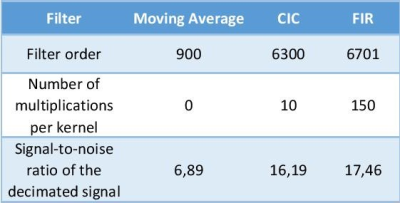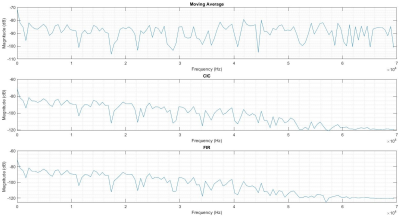0914
A digital MRI RF-receiver using an ordinary GPU1Otto-von-Guericke University, Magdeburg, Germany
Synopsis
We want to present a CUDA based RF-receiver for a 1,5 T MRI consisting of an inverse quadrature modulation and the decimation step. We compared different decimation techniques based on a moving average, a CIC and an FIR filter. The filters were compared regarding their noise attenuation, their processing effort and their group delays. We conclude that the CIC filter is the optimal filter for our usage, because this filter provides the best compromise between noise attenuation and processing effort.
Introduction
This work engages in the digital radio frequency (RF) receiver of an MRI. This receiver performs the inverse quadrature amplitude modulation (IQAM) including the mixing of the signal and the subsequent decimation. To achieve good decimation results, it is necessary to limit the bandwidth before the down sampling step to avoid aliasing. In this work we are comparing different decimation techniques based on averaging, FIR filtered and CIC filtered data. We compare their impact on the resulting image quality. A performance analysis based on our CUDA implementation is given as well. We relate our FIR filter to “GPU Acceleration of DSP for Communication Receivers" by Gunther et al. [1] and our CIC filter implementation to “Implementation of a Digital down Converter Using Graphics Processing Unit” by Ma et al. [2].Methods
The signal processing chain (Figure 1) is completely realized on a graphics card (GPU). Incoming signals are directly transferred via remote direct memory access (RDMA) to the GPU. The received MR-signals of the 1.5 T MRI are in the first step demixed by the IQAM. The demixing of a whole analog-digital converter (ADC) window results in a complex signal. To the real and the imaginary signal part, a decimation filter is applied. The three different decimation filter techniques, i.e., (1) moving averaging, (2) five-stages CIC filter (Figure 2), (3) five stages FIR filter (Figure 3) are applied in the following, respectively. Method (2) is combined with a compensation filter, realized as an inverse sinc. The compensation filter as well as the FIR filters were designed with the Parks McClellan Algorithm. The decimation reduces the sampling frequency to the k-space dimensions. One ADC-window is processed at once. These filters were compared regarding their group delays, their processing effort, and the signal to noise ratio (SNR) of the decimated signals. The filters were implemented in CUDA on a GPU. The SNR was calculated by the following equation with y as the decimated signal and n as noise. The noise is specified as the spectrum excluding the ground truth.\[SNR = \frac{\mathrm{max}(|\mathscr{F}(y)|)}{\mathrm{mean}(|n|)}\]
Results
The experiments showed that methods (2) and (3) achieved more than twice as high SNR-results than method (1), see Figure 4 and Table 1. The SNR-results of method (2) and (3) do not differ much. On the contrary, method (1) has the lowest processing effort, since no multiplications are required. Also method (2) provides with 10 multiplications per filter kernel a significantly better processing effort than method (3) with 150 multiplications. All methods provide constant group delays.Discussion
Method (1) has the worst noise attenuation but the lowest calculation effort. In contrast method (3) has a superior noise attenuation but the highest calculation effort. Method (2) provides a good trade-off between these two requirements. Our studies showed that method (2) is suitable to realize a digital MRI console which requires low calculation effort and high noise attenuation, see Table 1.Conclusion
We conclude that a digital RF-receiver for a 1.5 T MRI can be realized with a standard CUDA-graphic-card and one computer without further analog technique. In addition, it is possible to use different decimation methods and to choose the most suitable method according to the noise characteristics. Our method of choice is method (2). Furthermore our digital RF-receiver provides an economical solution.Acknowledgements
This work was supported by the research campus Stimulate.References
[1] Jake Gunther, Hyrum Gunther, and Todd Moon. “GPU Acceleration of DSP for Communication Receivers.” In: GNU radio 2 (Sept. 2017).
[2] Xiao Ma, Lixia Deng, and Yuping Zhao. “Implementation of a digital down converter using graphics processing unit”. In: 2013 15th IEEE International Conference on Communication Technology (Nov.2013).
Figures




